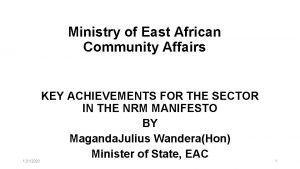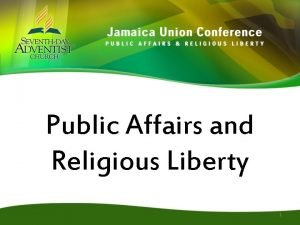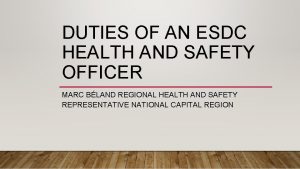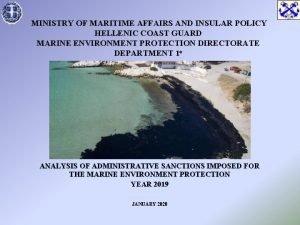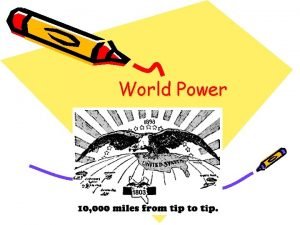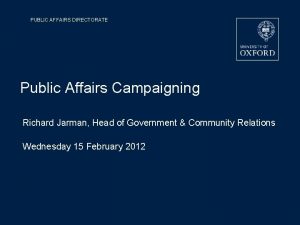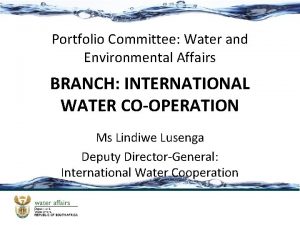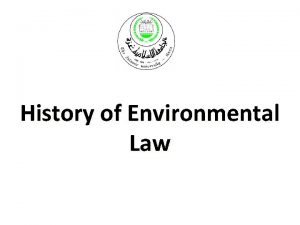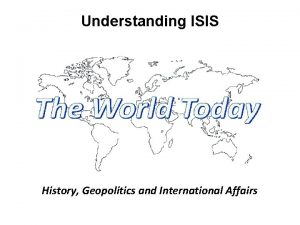History of International Environmental Affairs Most international environmental








































- Slides: 40

History of International Environmental Affairs Most international environmental initiatives have occurred since 1960, following the emergence of the modern environmental movement in the West There were modest efforts at regional and global cooperation for the environment dating as far back as the late 1800's, mostly emanating from Western Europe and North America. These efforts mirrored domestic environmental policy developments and were often concerned with wildlife conservation.

International Efforts pre-1960 • 1872: Swiss propose international commission to protect migratory birds • 1900: First formal agreement: Convention for the Preservation of Animals, Birds and Fish in Africa, signed in London by European colonial powers with the intent to protect African game species, especially to limit export of ivory to reduce severe hunting pressure on African elephant • 1900: European littoral states sign treaty to regulate transportation of toxic substances on Rhine River • 1909: Canada-US Boundary Waters Treaty • 1911: North Pacific Fur Seal Commission established by USA, Canada, USSR and Japan to regulate harvest of seals in North Pacific • 1918: US-Canada Migratory Bird Treaty Act, designed to protect bird species–esp. waterfowl--that seasonally migrate between the two nations

International Efforts pre-1960 • 1872: Swiss propose international commission to protect migratory birds • 1900: First formal agreement: Convention for the Preservation of Animals, Birds and Fish in Africa, signed in London by European colonial powers with the intent to protect African game species, especially to limit export of ivory to reduce severe hunting pressure on African elephant • 1900: European littoral states sign treaty to regulate transportation of toxic substances on Rhine River • 1909: Canada-US Boundary Waters Treaty • 1911: North Pacific Fur Seal Commission established by USA, Canada, USSR and Japan to regulate harvest of seals in North Pacific • 1918: US-Canada Migratory Bird Treaty Act, designed to protect bird species–esp. waterfowl--that seasonally migrate between the two nations

International Efforts pre-1960 • 1872: Swiss propose international commission to protect migratory birds • 1900: First formal agreement: Convention for the Preservation of Animals, Birds and Fish in Africa, signed in London by European colonial powers with the intent to protect African game species, especially to limit export of ivory to reduce severe hunting pressure on African elephant • 1900: European littoral states sign treaty to regulate transportation of toxic substances on Rhine River • 1909: Canada-US Boundary Waters Treaty • 1911: North Pacific Fur Seal Commission established by USA, Canada, USSR and Japan to regulate harvest of seals in North Pacific • 1918: US-Canada Migratory Bird Treaty Act, designed to protect bird species–esp. waterfowl--that seasonally migrate between the two nations

Early International Efforts, cont’d • 1931: First efforts to regulate commercial whaling, led (in 1946) to International Convention for the Regulation of Whaling and establishment of International Whaling Commission, a permanent body responsible for negotiating & setting policy re- the harvest and preservation of whales. • 1940: Convention on Nature Protection and Wildlife Conservation in the Western Hemisphere • 1946: Founding of the United Nations and World Bank, which would play leading roles in international environmental cooperation (World Bank, UNIMO, FAO, UNDP, WHO, UNEP & UNESCO) • 1954: International Convention for the Prevention of Pollution of the Sea by Oil, culmination of 28 years of negotiations by European and N. A. nations • 1958: International Maritime Consultative Organization (UN-IMCO) established with responsibility for negotiating international agreements on ocean pollution

Early International Efforts, cont’d • 1931: First efforts to regulate commercial whaling, led (in 1946) to International Convention for the Regulation of Whaling and establishment of International Whaling Commission, a permanent body responsible for negotiating & setting policy re- the harvest and preservation of whales. • 1940: Convention on Nature Protection and Wildlife Conservation in the Western Hemisphere • 1946: Founding of the United Nations and World Bank, which would play leading roles in international environmental cooperation (World Bank, UNIMO, FAO, UNDP, WHO, UNEP & UNESCO) • 1954: International Convention for the Prevention of Pollution of the Sea by Oil, culmination of 28 years of negotiations by European and N. A. nations • 1958: International Maritime Consultative Organization (UN-IMCO) established with responsibility for negotiating international agreements on ocean pollution

Early International Efforts, cont’d • 1931: First efforts to regulate commercial whaling, led (in 1946) to International Convention for the Regulation of Whaling and establishment of International Whaling Commission, a permanent body responsible for negotiating & setting policy re- the harvest and preservation of whales. • 1940: Convention on Nature Protection and Wildlife Conservation in the Western Hemisphere • 1946: Founding of the United Nations and World Bank, which would play leading roles in international environmental cooperation (World Bank, UNIMO, FAO, UNDP, WHO, UNEP & UNESCO) • 1954: International Convention for the Prevention of Pollution of the Sea by Oil, culmination of 28 years of negotiations by European and N. A. nations • 1958: International Maritime Consultative Organization (UN-IMCO) established with responsibility for negotiating international agreements on ocean pollution

International Efforts (1960 -1972) Context: Increase in international environmental efforts mirrored rise in Modern Environmental Movement in west • Cumulative environmental effects of Post-war boom (industrialization, prosperity, consumerism) • Affluence = greater concern over “quality of life” • New environmental science: e. g. , Rachel Carson “Silent Spring” published in 15 countries, 1962 • Growing media coverage of environmental events e. g. 1954 London “Killer Smog”, 1959 Mercury poisoning in Minimata Bay, 1967 Torrey Canyon oil spill in the English Channel • Rise of Vietnam, civil rights & counter-culture protests against status quo • Globalization of communication; increased recognition of interdependence among nations: Apollo 11 “Earth-rise” photo in 1969

Efforts 1960 -72, cont’d. • Creation of first prominent and truly international environmental NGO’s (e. g. , Greenpeace, WWF, etc. ) • Emergence of first “Green” political parties in New Zealand, Western Europe and Australia • Between 1970 and 1972: 14 industrialized nations established environmental ministries and passed significant environmental legislation (Environment Canada, Clean Water Act, Clean Air Act, etc. ) • But, little progress in LDC’s or Communist Bloc • 1971: RAMSAR Convention on Wetlands of International Importance • 1972: UNESCO-sponsored Convention for the Protection of World Cultural and Natural Heritage. • 1972: Oslo Convention for the Prevention of Marine Pollution by Dumping from Ships and Aircraft. • 1972: US-Can Great Lakes Water Quality Agreement

Efforts 1960 -72, cont’d. • Creation of first prominent and truly international environmental NGO’s (e. g. , Greenpeace, WWF, etc. ) • Emergence of first “Green” political parties in New Zealand, Western Europe and Australia • Between 1970 and 1972: 14 industrialized nations established environmental ministries and passed significant environmental legislation (Environment Canada, Clean Water Act, Clean Air Act, etc. ) • But, little progress in LDC’s or Communist Bloc • 1971: RAMSAR Convention on Wetlands of International Importance • 1972: UNESCO-sponsored Convention for the Protection of World Cultural and Natural Heritage. • 1972: Oslo Convention for the Prevention of Marine Pollution by Dumping from Ships and Aircraft. • 1972: US-Can Great Lakes Water Quality Agreement

Efforts 1960 -72, cont’d. • Creation of first prominent and truly international environmental NGO’s (e. g. , Greenpeace, WWF, etc. ) • Emergence of first “Green” political parties in New Zealand, Western Europe and Australia • Between 1970 and 1972: 14 industrialized nations established environmental ministries and passed significant environmental legislation (Environment Canada, Clean Water Act, Clean Air Act, etc. ) • But, little progress in LDC’s or Communist Bloc • 1971: RAMSAR Convention on Wetlands of International Importance • 1972: UNESCO-sponsored Convention for the Protection of World Cultural and Natural Heritage. • 1972: Oslo Convention for the Prevention of Marine Pollution by Dumping from Ships and Aircraft. • 1972: US-Can Great Lakes Water Quality Agreement

U. N. Stockholm Conference on the Human Environment (1972) UN General Assembly resolution to host international meeting “. . . to provide a framework for comprehensive consideration within the UN of the problems of the human environment in order to focus the attention of governments and public opinion on the importance and urgency of this question” • Preparatory period dominated by Western, industrialized countries • Soviet bloc boycotted effort because of ideological differences and unrelated political conflicts • LDCs encouraged to participate, but remained skeptical: feared environmental initiatives might get in way of economic development priorities • LDCs willing to cooperate, but only if development interests were not compromised and the West assisted them with finances and technology to invest in environmental protection. Also disapproved with West’s fixation on need for LDC population control.

U. N. Stockholm Conference on the Human Environment (1972) UN General Assembly resolution to host international meeting “. . . to provide a framework for comprehensive consideration within the UN of the problems of the human environment in order to focus the attention of governments and public opinion on the importance and urgency of this question” • Preparatory period dominated by Western, industrialized countries • Soviet bloc boycotted effort because of ideological differences and unrelated political conflicts • LDCs encouraged to participate, but remained skeptical: feared environmental initiatives might get in way of economic development priorities • LDCs willing to cooperate, but only if development interests were not compromised and the West assisted them with finances and technology to invest in environmental protection. Also disapproved with West’s fixation on need for LDC population control.

U. N. Stockholm Conference on the Human Environment (1972) UN General Assembly resolution to host international meeting “. . . to provide a framework for comprehensive consideration within the UN of the problems of the human environment in order to focus the attention of governments and public opinion on the importance and urgency of this question” • Preparatory period dominated by Western, industrialized countries • Soviet bloc boycotted effort because of ideological differences and unrelated political conflicts • LDCs encouraged to participate, but remained skeptical: feared environmental initiatives might get in way of economic development priorities • LDCs willing to cooperate, but only if development interests were not compromised and the West assisted them with finances and technology to invest in environmental protection. Also disapproved with West’s fixation on need for LDC population control.

Stockholm, cont’d 114 nations, 1200 delegates (2 heads of state)–large by UN standards. Much media coverage and 500 NGO’s participated in parallel “Environmental Forum”. Outcomes… • • • Stockholm Declaration of the UN Conference on the Human Environment: 26 principles, intended as a foundation for future developments in international environmental cooperation–established basic principles of international environmental law. Action Plan for the Human Environment: 109 recommendations for govt and inter-govt. action on issues ranging from species conservation, forests and atmospheric and marine pollution, to development policy, human settlements, and technology transfer. Established United Nations Environment Program (UNEP) and Environment Fund Formal acknowledgment of Additionality Principle: wealthy North should pay for some or all of added costs of environmental initiatives in developing south Emergence of environmental civil society movement as a significant international stakeholder

Stockholm, cont’d 114 nations, 1200 delegates (2 heads of state)–large by UN standards. Much media coverage and 500 NGO’s participated in parallel “Environmental Forum”. Outcomes… • • • Stockholm Declaration of the UN Conference on the Human Environment: 26 principles, intended as a foundation for future developments in international environmental cooperation–established basic principles of international environmental law. Action Plan for the Human Environment: 109 recommendations for govt and inter-govt. action on issues ranging from species conservation, forests and atmospheric and marine pollution, to development policy, human settlements, and technology transfer. Established United Nations Environment Program (UNEP) and Environment Fund Formal acknowledgment of Additionality Principle: wealthy North should pay for some or all of added costs of environmental initiatives in developing south Emergence of environmental civil society movement as a significant international stakeholder

Stockholm, cont’d 114 nations, 1200 delegates (2 heads of state)–large by UN standards. Much media coverage and 500 NGO’s participated in parallel “Environmental Forum”. Outcomes… • • • Stockholm Declaration of the UN Conference on the Human Environment: 26 principles, intended as a foundation for future developments in international environmental cooperation–established basic principles of international environmental law. Action Plan for the Human Environment: 109 recommendations for govt and inter-govt. action on issues ranging from species conservation, forests and atmospheric and marine pollution, to development policy, human settlements, and technology transfer. Established United Nations Environment Program (UNEP) and Environment Fund Formal acknowledgment of Additionality Principle: wealthy North should pay for some or all of added costs of environmental initiatives in developing south Emergence of environmental civil society movement as a significant international stakeholder

Stockholm, cont’d 114 nations, 1200 delegates (2 heads of state)–large by UN standards. Much media coverage and 500 NGO’s participated in parallel “Environmental Forum”. Outcomes… • • • Stockholm Declaration of the UN Conference on the Human Environment: 26 principles, intended as a foundation for future developments in international environmental cooperation–established basic principles of international environmental law. Action Plan for the Human Environment: 109 recommendations for govt and inter-govt. action on issues ranging from species conservation, forests and atmospheric and marine pollution, to development policy, human settlements, and technology transfer. Established United Nations Environment Program (UNEP) and Environment Fund Formal acknowledgment of Additionality Principle: wealthy North should pay for some or all of added costs of environmental initiatives in developing south Emergence of environmental civil society movement as a significant international stakeholder

Stockholm, cont’d 114 nations, 1200 delegates (2 heads of state)–large by UN standards. Much media coverage and 500 NGO’s participated in parallel “Environmental Forum”. Outcomes… • • • Stockholm Declaration of the UN Conference on the Human Environment: 26 principles, intended as a foundation for future developments in international environmental cooperation–established basic principles of international environmental law. Action Plan for the Human Environment: 109 recommendations for govt and inter-govt. action on issues ranging from species conservation, forests and atmospheric and marine pollution, to development policy, human settlements, and technology transfer. Established United Nations Environment Program (UNEP) and Environment Fund Formal acknowledgment of Additionality Principle: wealthy North should pay for some or all of added costs of environmental initiatives in developing south Emergence of environmental civil society movement as a significant international stakeholder

Stockholm, cont’d 114 nations, 1200 delegates (2 heads of state)–large by UN standards. Much media coverage and 500 NGO’s participated in parallel “Environmental Forum”. Outcomes… • • • Stockholm Declaration of the UN Conference on the Human Environment: 26 principles, intended as a foundation for future developments in international environmental cooperation–established basic principles of international environmental law. Action Plan for the Human Environment: 109 recommendations for govt and inter-govt. action on issues ranging from species conservation, forests and atmospheric and marine pollution, to development policy, human settlements, and technology transfer. Established United Nations Environment Program (UNEP) and Environment Fund Formal acknowledgment of Additionality Principle: wealthy North should pay for some or all of added costs of environmental initiatives in developing south Emergence of environmental civil society movement as a significant international stakeholder

Between Stockholm & Rio (1972 -1992) Developed Western Nations: • Much progress with domestic legislation and programs had been made in the late 1960 s/early 1970's. The benefits of these efforts were being felt by the late 1970 s, with improvements in water & air quality, reductions in toxins like lead & DDT, and increases in protected areas. Lesser Developed Nations: • Environmental conditions deteriorated severely: urban pollution & squaller, deforestation, soil erosion, water-born diseases. In spite of opposition at Stockholm, many LDCs began to respond by establishing environmental ministries & associated laws (from 11 nations in 1972 to 102 in 1980). As well, many moved ahead with aggressive population planning (e. g. India, China). Soviet Bloc: • Environmental problems worsened: air & water pollution, nuclear contamination, environmental health & disease. • Had boycotted Stockholm and made limited progress afterward (economic growth remained the priority). Civic activism & information remained suppressed until the fall of Communism in late 1980's

Between Stockholm & Rio (1972 -1992) Developed Western Nations: • Much progress with domestic legislation and programs had been made in the late 1960 s/early 1970's. The benefits of these efforts were being felt by the late 1970 s, with improvements in water & air quality, reductions in toxins like lead & DDT, and increases in protected areas. Lesser Developed Nations: • Environmental conditions deteriorated severely: urban pollution & squaller, deforestation, soil erosion, water-born diseases. In spite of opposition at Stockholm, many LDCs began to respond by establishing environmental ministries & associated laws (from 11 nations in 1972 to 102 in 1980). As well, many moved ahead with aggressive population planning (e. g. India, China). Soviet Bloc: • Environmental problems worsened: air & water pollution, nuclear contamination, environmental health & disease. • Had boycotted Stockholm and made limited progress afterward (economic growth remained the priority). Civic activism & information remained suppressed until the fall of Communism in late 1980's

Between Stockholm & Rio (1972 -1992) Developed Western Nations: • Much progress with domestic legislation and programs had been made in the late 1960 s/early 1970's. The benefits of these efforts were being felt by the late 1970 s, with improvements in water & air quality, reductions in toxins like lead & DDT, and increases in protected areas. Lesser Developed Nations: • Environmental conditions deteriorated severely: urban pollution & squaller, deforestation, soil erosion, water-born diseases. In spite of opposition at Stockholm, many LDCs began to respond by establishing environmental ministries & associated laws (from 11 nations in 1972 to 102 in 1980). As well, many moved ahead with aggressive population planning (e. g. India, China). Soviet Bloc: • Environmental problems worsened: air & water pollution, nuclear contamination, environmental health & disease. • Had boycotted Stockholm and made limited progress afterward (economic growth remained the priority). Civic activism & information remained suppressed until the fall of Communism in late 1980's

Between Stockholm and Rio, cont’d • • 1972: London Convention for the Prevention of Marine Pollution by Dumping of Wastes (toxic & nuclear waste dumping at sea). 1973: International Convention for the Prevention of Pollution from Ships (MARPOL). 1973: Convention on the International Trade of Endangered Species (CITES). 1974: Paris & Helsinki Conventions to protect marine environments of the North and Baltic Seas. 1974/84: 1 st & 2 nd UN Population Conferences. 1979: Convention on Long-Range, Transboundary Air Pollution (LRTAP). Canada, US & Europe agreement to address concerns about acid rain; first major international effort to regulate air pollution. 1980: IUCN/WWF/UNEP World Conservation Strategy. promoted conservation planning in LDCs.

Cont’d… • 1982: UN Conference on the Law of the Sea (UNCLOS). 200 mile territorial jurisdictions established, etc. • 1982: IWC commercial whaling moratorium. • 1987: Montreal Protocol on Substances that Deplete the Ozone Layer • 1988: Intergovernmental Panel on Climate Change formed by UNEP & WMO • 1989: Basel Convention on the Control of Trans-boundary Movements of Hazardous Wastes • 1991: Canada-US Air Quality Agreement to reduce SO 2 emissions that cause acid rain • 1991: Protocol on Environmental Protection of Antarctica: moratorium on mineral and related exploration and development for 50 years • European Union: Broad progress on regional, international environmental cooperation pertaining to toxics, water quality, waste management, air pollution, wildlife protection and noise pollution

Rio Summit UN Conference on Environment & Development (1992) Context: • “Rio Summit” needs to be seen in light of the rapid resurgence of environmental concern in the 1980 s. New, ominous environmental problems emerging and resulting media coverage: * Three Mile Island nuclear mishap (1979) * Bhopal Union Carbide chemical accident (1984) * Ozone hole over Antarctica discovered (1985) * Chernobyl nuclear accident (1986) * Severe drought/famine in Africa (mid-80 s) * Caribbean hurricane David (1988) * Severe floods in Bangladesh (1988) * Assassination of activist Chico Mendes (1989? ) * Time magazine (1988): “Earth: Planet of the Year” * Exxon Valdez oil spill in Alaska (1989) Effect: • Record growth in environmental NGO membership • Huge support for Green parties in Europe & Australia • Growing pressure on governments to act

Rio Summit UN Conference on Environment & Development (1992) Context: • “Rio Summit” needs to be seen in light of the rapid resurgence of environmental concern in the 1980 s. New, ominous environmental problems emerging and resulting media coverage: * Three Mile Island nuclear mishap (1979) * Bhopal Union Carbide chemical accident (1984) * Ozone hole over Antarctica discovered (1985) * Chernobyl nuclear accident (1986) * Severe drought/famine in Africa (mid-80 s) * Caribbean hurricane David (1988) * Severe floods in Bangladesh (1988) * Assassination of activist Chico Mendes (1989? ) * Time magazine (1988): “Earth: Planet of the Year” * Exxon Valdez oil spill in Alaska (1989) Effect: • Record growth in environmental NGO membership • Huge support for Green parties in Europe & Australia • Growing pressure on governments to act

Rio Summit UN Conference on Environment & Development (1992) Context: • “Rio Summit” needs to be seen in light of the rapid resurgence of environmental concern in the 1980 s. New, ominous environmental problems emerging and resulting media coverage: * Three Mile Island nuclear mishap (1979) * Bhopal Union Carbide chemical accident (1984) * Ozone hole over Antarctica discovered (1985) * Chernobyl nuclear accident (1986) * Severe drought/famine in Africa (mid-80 s) * Caribbean hurricane David (1988) * Severe floods in Bangladesh (1988) * Assassination of activist Chico Mendes (1989? ) * Time magazine (1988): “Earth: Planet of the Year” * Exxon Valdez oil spill in Alaska (1989) Effect: • Record growth in environmental NGO membership • Huge support for Green parties in Europe & Australia • Growing pressure on governments to act

Rio Summit UN Conference on Environment & Development (1992) Context: • “Rio Summit” needs to be seen in light of the rapid resurgence of environmental concern in the 1980 s. New, ominous environmental problems emerging and resulting media coverage: * Three Mile Island nuclear mishap (1979) * Bhopal Union Carbide chemical accident (1984) * Ozone hole over Antarctica discovered (1985) * Chernobyl nuclear accident (1986) * Severe drought/famine in Africa (mid-80 s) * Caribbean hurricane David (1988) * Severe floods in Bangladesh (1988) * Assassination of activist Chico Mendes (1989? ) * Time magazine (1988): “Earth: Planet of the Year” * Exxon Valdez oil spill in Alaska (1989) Effect: • Record growth in environmental NGO membership • Huge support for Green parties in Europe & Australia • Growing pressure on governments to act

Rio Summit, cont’d. • 1985 -87: World Commission on Environment & Development: UN special commission composed of senior officials tasked by UN General Assembly to evaluate state of the global environment and development. Findings published in Our Common Future (1987). Document had tremendous impact because: * Timing coincided with high environmental concern * Credibility and pragmatism of the authors Our Common Future made popular “sustainable development: development which meets the needs of the present without compromising the ability of future generations to meet their own needs”. • UN General Assembly subsequently sponsored UN Conference on Environment and Development to address many of the issues raised in Our Common Future. • The “Rio Summit” was first-ever “World Summit” and was unprecedented in scale: * Largest meeting of world leaders ever: 178 nations; 118 heads of state * 1, 400 NGOs present in parallel “Global Forum” with 18, 000 participants

Rio Summit, cont’d. • 1985 -87: World Commission on Environment & Development: UN special commission composed of senior officials tasked by UN General Assembly to evaluate state of the global environment and development. Findings published in Our Common Future (1987). Document had tremendous impact because: * Timing coincided with high environmental concern * Credibility and pragmatism of the authors Our Common Future made popular “sustainable development: development which meets the needs of the present without compromising the ability of future generations to meet their own needs”. • UN General Assembly subsequently sponsored UN Conference on Environment and Development to address many of the issues raised in Our Common Future. • The “Rio Summit” was first-ever “World Summit” and was unprecedented in scale: * Largest meeting of world leaders ever: 178 nations; 118 heads of state * 1, 400 NGOs present in parallel “Global Forum” with 18, 000 participants

Rio Summit, cont’d. • 1985 -87: World Commission on Environment & Development: UN special commission composed of senior officials tasked by UN General Assembly to evaluate state of the global environment and development. Findings published in Our Common Future (1987). Document had tremendous impact because: * Timing coincided with high environmental concern * Credibility and pragmatism of the authors Our Common Future made popular “sustainable development: development which meets the needs of the present without compromising the ability of future generations to meet their own needs”. • UN General Assembly subsequently sponsored UN Conference on Environment and Development to address many of the issues raised in Our Common Future. • The “Rio Summit” was first-ever “World Summit” and was unprecedented in scale: * Largest meeting of world leaders ever: 178 nations; 118 heads of state * 1, 400 NGOs present in parallel “Global Forum” with 18, 000 participants

Key Outcomes of Rio Summit • Rio Declaration: statement of key principles on environment & development • Agenda 21: detailed list of recommendations • Statement of Forest Principles: watered down version of forest convention • Biodiversity Convention: weakened by United States. • Climate Change Convention: Pre-cursor to Kyoto Protocol • Global Environment Facility (GEF): finance investments in environmental protection in LDCs • UN Commission on Sustainable Development: Provide follow-up to Rio

Progress Since Rio… • 1993: North American Commission for Environmental Cooperation: NAFTA side agreement • 1994: 3 rd International Population Conference, Cairo. • 1997: International agreement to reduce the production, storage and use of land mines. • 1997: Kyoto Protocol on the Reduction of Greenhouse Gases. • 1998: Rotterdam Convention on Prior Informed Consent for trade in hazardous chemicals and pesticides • 2000: Ozone Annex to 1991 Canada-US Air Quality Agreement, smog-causing emissions (NO-x) • 2001: Cartegena Biosafety Protocol on Genetically Modified Organisms (Biodiversity Convention) • 2001: UN-Stockholm Convention on Persistent Organic Pollutants (DDT, PCBs, dioxin)

UN World Summit for Sustainable Development: Rio + 10, Johannesburg, 2002 • Follow-up to 1992 Earth Summit • Event held in the wake of 9 -11 and in the context of a right-wing, unilateralist US administration with little interest in the environmental agenda and little support for UN initiatives • Summit high on rhetoric and platitudes, low on actual accomplishments • Discussions focused more on meeting specific development rather than environmental objectives • Constructive engagement of private-public sector partnerships, etc. • Goals established to increase peoples’ access to sanitation, safe drinking water, etc.

UN World Summit for Sustainable Development: Rio + 10, Johannesburg, 2002 • Follow-up to 1992 Earth Summit • Event held in the wake of 9 -11 and in the context of a right-wing, unilateralist US administration with little interest in the environmental agenda and little support for UN initiatives • Summit high on rhetoric and platitudes, low on actual accomplishments • Discussions focused more on meeting specific development rather than environmental objectives • Constructive engagement of private-public sector partnerships, etc. • Goals established to increase peoples’ access to sanitation, safe drinking water, etc.

UN World Summit for Sustainable Development: Rio + 10, Johannesburg, 2002 • Follow-up to 1992 Earth Summit • Event held in the wake of 9 -11 and in the context of a right-wing, unilateralist US administration with little interest in the environmental agenda and little support for UN initiatives • Summit high on rhetoric and platitudes, low on actual accomplishments • Discussions focused more on meeting specific development rather than environmental objectives • Constructive engagement of private-public sector partnerships, etc. • Goals established to increase peoples’ access to sanitation, safe drinking water, etc.

Recent Progress (or Not!) (2002 +) • Climate change has emerged as pre-eminent global environmental issue • Yet, progress on this and other international environmental challenges has been uneven, with considerable gains within the European Union; but virtually none in the Americas • 9/11 & US-led “War on Terrorism”, combined with an ideological antipathy to government regulation and multilateralism, has undermined progress on climate change, etc. • Emerging economies of China, India and Brazil assuming a much greater political voice and influence on the world stage but, for the most part so far, have not made environmental concerns a priority • Momentum appears now to be shifting again in a green direction as George W. Bush fades from the scene, Barack Obama ascends, and evidence of global warming mounts

Recent Progress (or Not!) (2002 +) • Climate change has emerged as pre-eminent global environmental issue • Yet, progress on this and other international environmental challenges has been uneven, with considerable gains within the European Union; but virtually none in the Americas • 9/11 & US-led “War on Terrorism”, combined with an ideological antipathy to government regulation and multilateralism, has undermined progress on climate change, etc. • Emerging economies of China, India and Brazil assuming a much greater political voice and influence on the world stage but, for the most part so far, have not made environmental concerns a priority • Momentum appears now to be shifting again in a green direction as George W. Bush fades from the scene, Barack Obama ascends, and evidence of global warming mounts

Recent Progress (or Not!) (2002 +) • Climate change has emerged as pre-eminent global environmental issue • Yet, progress on this and other international environmental challenges has been uneven, with considerable gains within the European Union; but virtually none in the Americas • 9/11 & US-led “War on Terrorism”, combined with an ideological antipathy to government regulation and multilateralism, has undermined progress on climate change, etc. • Emerging economies of China, India and Brazil assuming a much greater political voice and influence on the world stage but, for the most part so far, have not made environmental concerns a priority • Momentum appears now to be shifting again in a green direction as George W. Bush fades from the scene, Barack Obama ascends, and evidence of global warming mounts
 Mh 605
Mh 605 Hhs office of population affairs
Hhs office of population affairs Ministry of east african community affairs uganda
Ministry of east african community affairs uganda Ics undergraduate student affairs
Ics undergraduate student affairs Amtrak government affairs
Amtrak government affairs Va debt waiver request letter sample
Va debt waiver request letter sample Foreign affairs trouble the nation
Foreign affairs trouble the nation Chapter 12 foreign affairs in the young nation
Chapter 12 foreign affairs in the young nation Sjsu faculty affairs
Sjsu faculty affairs South carolina human affairs commission right to sue
South carolina human affairs commission right to sue Public affairs and religious liberty
Public affairs and religious liberty Public affairs marketing
Public affairs marketing The borgen project internship
The borgen project internship Utsa advisors
Utsa advisors Harvard university alumni affairs and development
Harvard university alumni affairs and development Regulatory affairs kpi
Regulatory affairs kpi Graduate academic affairs iit
Graduate academic affairs iit Post approval regulatory affairs
Post approval regulatory affairs Labour affairs officer esdc
Labour affairs officer esdc Don't be entangled with the affairs of this world
Don't be entangled with the affairs of this world Humphrey school of public affairs
Humphrey school of public affairs Human affairs commission
Human affairs commission Public affairs directorate oxford
Public affairs directorate oxford Simon conway quiz
Simon conway quiz Strategic public affairs
Strategic public affairs Tula tungkol sa karapatan ng mga konsyumer
Tula tungkol sa karapatan ng mga konsyumer Ucf college of health and public affairs
Ucf college of health and public affairs Sample letter to minister of foreign affairs
Sample letter to minister of foreign affairs Public affairs networking
Public affairs networking Ministry of maritime affairs and insular policy
Ministry of maritime affairs and insular policy Department of licensing and regulatory affairs
Department of licensing and regulatory affairs Medical staff affairs
Medical staff affairs Hellenic ministry of education and religious affairs
Hellenic ministry of education and religious affairs What is noninvolvement in world affairs?
What is noninvolvement in world affairs? Critical issues in student affairs
Critical issues in student affairs Va form 10-250
Va form 10-250 Everyday affairs
Everyday affairs Crealde school of art
Crealde school of art Student affairs office
Student affairs office A national policy of avoiding involvement in world affairs
A national policy of avoiding involvement in world affairs European parliament legal affairs committee
European parliament legal affairs committee


